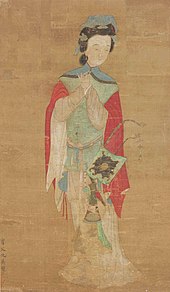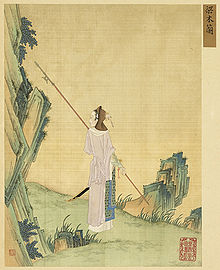|
Hua Mulan
Hua Mulan (Chinese: 花木蘭) is a legendary Chinese folk heroine from the Northern and Southern dynasties era (4th to 6th century CE) of Chinese history. Scholars generally consider Mulan to be a fictional character. Hua Mulan is depicted in the Wu Shuang Pu (無雙譜, Table of Peerless Heroes) by Jin Guliang.[citation needed] OverviewAccording to legend, Mulan took her aged father's place in the conscription for the army by disguising herself as a man. In the story, after prolonged and distinguished military service against nomadic hordes beyond the northern frontier, Mulan is honored by the emperor but declines a position of high office. She retires to her hometown, where she is reunited with her family and, much to the astonishment of her comrades, reveals herself as a woman. First mentionsThe first written record of Mulan is the Ballad of Mulan,[note 1] a folk song believed to have been composed during the Northern Wei dynasty (386–535 CE) and included in an anthology of books and songs during the Southern Chen dynasty (557–589 CE). While this anthology is itself lost, significant excerpts, including the Ballad of Mulan, survive in the Song dynasty anthology Yuefu Shiji (Chinese: 樂府詩集).[note 2] The historical setting of the Ballad of Mulan is usually the Northern Wei's military campaigns against the nomadic Rouran. A later adaptation has Mulan active around the founding of the Tang dynasty (c. 620 CE).[1] The story of Mulan was taken up in a number of later works, including the 17th-century work of historical fiction Romance of Sui and Tang,[note 3] and many screen and stage adaptations. Sources The Ballad of Mulan was first transcribed in the Musical Records of Old and New,[note 4] a compilation of books and songs by the monk Zhijiang in the Southern Chen dynasty in the 6th century. The earliest extant text of the poem comes from an 11th- or 12th-century anthology known as the Music Bureau Collection,[note 5] whose author, Guo Maoqian, explicitly mentions the Musical Records of Old and New as his source for the poem. As a ballad, the lines do not necessarily have equal numbers of syllables. The poem consists of 31 couplets and is mostly composed of five-character phrases, with a few extending to seven or nine.[citation needed] An adaptation by playwright Xu Wei (d. 1593) dramatized the tale as "The Female Mulan" [note 6] or, more fully, "The Heroine Mulan Goes to War in Her Father's Place",[note 7] in two acts.[2][3] Later, the character of Mulan was incorporated into the Romance of Sui and Tang, a novel written by Chu Renhuo (褚人獲).[4][5] Over time, the story of Mulan rose in popularity as a folk tale among the Chinese people.[citation needed] NameThe heroine of the poem is given different family names in different versions of her story. The Musical Records of Old and New states Mulan's given name is not known and therefore implies Mulan is her surname.[6] As the Ballad of Mulan is set in the Northern Wei dynasty when northern China was ruled by ethnic Xianbei, a proto-Mongolic people, there is some evidence that Mulan was not ethnic Han Chinese but Xianbei, who had exclusively compound surnames.[6] Mulan may have been the sinified version of the Xianbei word "umran" which means prosperous.[6] According to later books such as Female Mulan, her family name is Zhu (朱), while the Romance of Sui and Tang says it is Wei (魏). The family name Hua (花; Huā; 'flower'), which was introduced by Xu Wei,[2] has become the most popular in recent years, in part because of its more poetic meaning and association with the given name "Mulan" (木蘭), which literally means "magnolia".[citation needed] HistoricityMulan's name is included in Yan Xiyuan's One Hundred Beauties, which describes a number of women from Chinese folklore. It is still unclear whether Mulan was a historical person or just a legend, as her name does not appear in Exemplary Women, a collection of biographies of women who lived during Northern Wei dynasty.[7] Although The Ballad of Mulan itself does not expressly indicate the historical setting, the story is commonly attributed to the Northern Wei dynasty due to geographic and cultural references in the ballad.[6] The Northern Wei dynasty was founded by the Tuoba clan of ethnic Xianbei who united northern China in the 4th century CE (Conquest dynasty). The Tuoba Xianbei rulers were themselves nomads from the northern steppes and became sinified as they ruled and settled in northern China.[6] The Tuoba Xianbei took on the Chinese dynasty name "Wei", changed their own surname from "Tuoba" to "Yuan", and moved the capital from Pingcheng, modern-day Datong, Shanxi in the northern periphery of Imperial China, to Luoyang, south of the Yellow River, in the Central Plain, the traditional heartland of China.[6] The emperors of the Northern Wei were known both by the sacred Chinese title, "Son of Heaven", and by "Khagan", the title of the leader of nomadic kingdoms. The Ballad of Mulan refers to the sovereign by both titles. The Northern Wei also adopted the governing institutions of Imperial China, and the office of shangshulang (尚書郎) the Khagan offered Mulan is a ministerial position within the shangshusheng (尚書省), the highest organ of executive power under the emperor.[8] This offering indicates Mulan was trained in the martial arts and literary arts as she was capable of serving as a civilian official charged with issuing and interpreting written government orders.[citation needed] The Xianbei in China also retained certain nomadic traditions, and Xianbei women were typically skilled horseback riders.[6] Another popular Northern Wei folk poem called "Li Bo's Younger Sister" praises Yong Rong, Li Bo's younger sister, for her riding and archery skills.[6] The Ballad of Mulan may have reflected the gender roles and status of women in nomadic societies.[9] The Northern Wei was engaged in protracted military conflict with the nomadic Rouran, who frequently raided the northern Chinese frontier to loot and pillage.[6] Northern Wei emperors considered the Rouran to be uncivilized "barbarians" and called them Ruanruan (Chinese: 蠕蠕) or "wriggling worms".[10] According to the Book of Wei, the dynasty's official history, Emperor Taiwu of Northern Wei launched a military expedition in 429 against the Rouran by advancing on the Black Mountain and then extending northward to the Yanran Mountain.[6] Both locations are cited in The Ballad. The Black Mountain corresponds to Shahu Mountain (殺虎山), located southeast of modern-day Hohhot in Inner Mongolia. Yan Mountain, the shorthand for Yanran Mountain (燕然山), is now known as the Khangai Mountains of central Mongolia.[10] The Northern Wei sought to protect the frontier by establishing a string of frontier garrison commands across what is today Inner Mongolia.[citation needed] Ballad of Mulan Mulan sighs at her loom.[11][12] The Khagan is mobilizing the military, and her father is named in each of the conscription notices from the emperor. As the eldest child, she decides to take her father's place. She buys a fine horse from the eastern market, saddle and stirrup from the western market, bridle and reins from the southern market and a long whip from the northern market. She bids farewell to her parents in the morning and leaves for the Black Mountain, encamping by the Yellow River in the evening, where she cannot hear the calls of her parents due to the rushing waters; only the sounds of the barbarians' cavalry in the Yan Mountains. She advances ten thousand li to battle as if flying past the mountains. The sound of the sentry gong cuts through the cold night air, and the moonlight reflects off her metal armor. A hundred battles take place, and generals die. After the ten-year campaign, the veterans return to meet the Son of Heaven (Mandate of Heaven), enthroned in the splendid palace, who confers promotions in rank and prizes of hundreds of thousands. He asks Mulan what she would like. Mulan turns down the high-ranking position of shangshulang in the central government, and asks only for a speedy steed to take her home. Her parents, upon hearing her return, welcome her outside their hometown. Her elder sister puts on her fine dress. Her younger brother sharpens the knife for the swine and sheep. Mulan returns to her room, changes from her tabard into her old clothes. She combs her hair by the window and, before the mirror, fastens golden yellow flowers. Her comrades are shocked to see her. For twelve years of their enlistment together, they hadn't realized that she was a woman. Mulan responses:[13][14][15]
Romance of Sui and TangChu Renhuo's Romance of the Sui and Tang (c. 1675) provides additional backdrops and plot-twists.[4] Here, Mulan lives under the rule of Heshana Khan of the Western Turkic Khaganate. When the Khan agrees to wage war in alliance with the emergent Tang dynasty, which was poised to conquer all of China, Mulan's father Hua Hu (Chinese: 花弧) fears he will be conscripted into military service since he only has two daughters and an infant son. Mulan crossdresses as a man and enlists in her father's stead. She is intercepted by the forces of the Xia king Dou Jiande and is brought under questioning by the king's warrior daughter Xianniang (Chinese: 線娘), who tries to recruit Mulan as a man. Discovering Mulan to be a fellow female warrior, she is so delighted that they become sworn sisters.[5][16] In the Sui Tang Romance, Mulan comes to a tragic end, a "detail that cannot be found in any previous legends or stories associated Hua Mulan", and believed to have been interpolated by the author Chu Renho.[5] Xianniang's father is vanquished after siding with the enemy of the Tang dynasty, and the two sworn sisters, with knives in their mouths, surrender themselves to be executed in the place of the condemned man. This act of filial piety wins a reprieve from Emperor Taizong of Tang, and the imperial consort, who was birth-mother to the Emperor, bestows money to Mulan to provide for her parents, as well as wedding funds for the princess, who had confessed to having promised herself to general Luó Chéng (Chinese: 羅成).[17] In reality, Dou Jiande was executed, but in the novel he lives on as a monk.[citation needed] Mulan is given leave to journey back to her homeland, and once arrangements were made for Mulan's parents to relocate, it is expected that they will all be living in the princess's old capital of Leshou (Chinese: 樂壽, modern Xian County, Hebei). Mulan is devastated to discover her father has long died and her mother has remarried. According to the novel, Mulan's mother was surnamed Yuan (袁) and remarried a man named Wei (魏). Even worse, the Khan has summoned her to the palace to become his concubine.[18] Rather than to suffer this fate, she dies by suicide. But before she dies, she entrusts an errand to her younger sister, Youlan (Chinese: 又蘭), which was to deliver Xianniang's letter to her fiancé, Luó Chéng. This younger sister dresses as a man to make her delivery, but her disguise is discovered, and it arouses her recipient's amorous attention.[19] The Mulan character's suicide has been described as "baffling", since she is not in love or engaged to anyone. Some commentators have explained this as an anti-Qing message: the author supposedly wanted to suggest that "even a half-Chinese woman would prefer death by her own hand to serving a foreign ruler".[18] In the novel, Mulan's mother was from the Central Plain of China, but her father was from Hebei during the Northern Wei dynasty[20] and presumably of Turkic (Xianbei) origin, which would make her only half-Chinese.[18] Modern adaptations The story of Hua Mulan has inspired a number of screen and stage adaptations. Stage
Films
Television series
Literature
Children's books
Video games
Tribute in astronomyThe Hua Mulan crater on Venus is named for her.[29][30] See also
Notes
References
Sources
Further reading
External links
|
||||||||||||||||||||||||||||||||||||||||||||||||||||||||||||||
